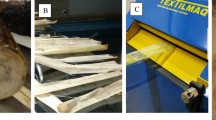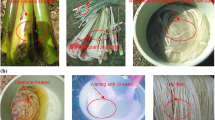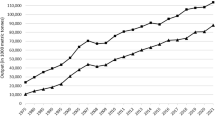Summary
InPinus taeda L., burst, breaking length, and sheet density were improved by using fiber refined from wood having long, narrow-diameter tracheids with thick walls. Only narrowdiameter tracheids with thick walls were required to improve tear factor. A theoretical stress analysis revealed that thick-walled cells of small outside diameter fail by diagonal tension or parallel shear, depending on the fibril angle, while under torsional stress during refining. Such failures result in ribbon-like fragments which research elsewhere has demonstrated to provide the coherence necessary for strength development in mechanical pulps. In contrast, thinwalled cells of small outside diameter fail by diagonal compression and yield few ribbons. Long fibers are more desirable than short fibers because of greater induced stresses and improved chances of axial alignment between the disks.
Zusammenfassung
Berstdruck, Reißlänge und Blattdichte vonPinus taeda L., wurden durch Verwendung von Refiner-Fasern aus Holz, das lange Tracheiden mit geringem Durchmesser und dicken Wänden besitzt, verbessert. Zur Verbesserung des Reißfaktors waren ausschließlich dickwandige Tracheiden mit geringem Durchmesser erforderlich. Eine Spannungsanalyse zeigte, daß dickwandige Zellen mit kleinem Außendurchmesser durch diagonale Zug- oder parallele Scherbeanspruchung in Abhängigkeit vom Fibrillenanstiegswinkel während der Torsionsbelastung im Refiner reißen. Durch diesen Bruchvorgang ergeben sich bandförmige Bruchstücke, die nachgewiesenermaßen notwendig sind, um den inneren Zusammenhalt für die Festigkeitsentwicklung in mechanischem Zellstoff zu ermöglichen. Im Gegensatz hierzu brechen dünnwandige Zellen mit kleinem Außendurchmesser mehr durch diagonale Druckbeanspruchung und es ergeben sich nur wenige Bänder. Lange Fasern sind insofern erwünschter als kurze, da sie zu höheren Festigkeiten führen und eine höhere Wahrscheinlichkeit ihrer axialen Ausrichtung zwischen den Refinerscheiben besteht.
Similar content being viewed by others
References
Atack, D., andW. D. May: Mechanical reduction of chips by double-disk refining. Pulp Pap. Mag. Can.64 (1963) No. C, T75/T83, T118.
Forgacs, O. L.: The characterization of mechanical pulp. Pulp Pap. Mag. Can.64 (1963) No. C, T89/T118.
May, W. D., E. L. Morris andD. Atack: Dynamics of a visco-elastic wear particle between sliding surfaces. J. Appl. Phys.34 (1963) 1920/1928.
McMillin, C. W.: Gross wood characteristics affecting properties of handsheets made from Loblolly pine refiner groundwood. TAPPI51 (1968) 51/56.
Author information
Authors and Affiliations
Additional information
The author appreciatively acknowledges the assistance of the Roy O. Martin Lumber Co., Alexandria, La.;R. A. Leask andJ. Adams of Bauer Bros. Co., Springfield, Ohio; andD. Bower, statistician at the Southern Forest Experiment Station, New Orleans, La.
Rights and permissions
About this article
Cite this article
McMillin, C.W. Aspects of fiber morphology affecting properties of handsheets made from Loblolly pine refiner groundwood. Wood Sci.Technol. 3, 139–149 (1969). https://doi.org/10.1007/BF00639637
Received:
Issue Date:
DOI: https://doi.org/10.1007/BF00639637




